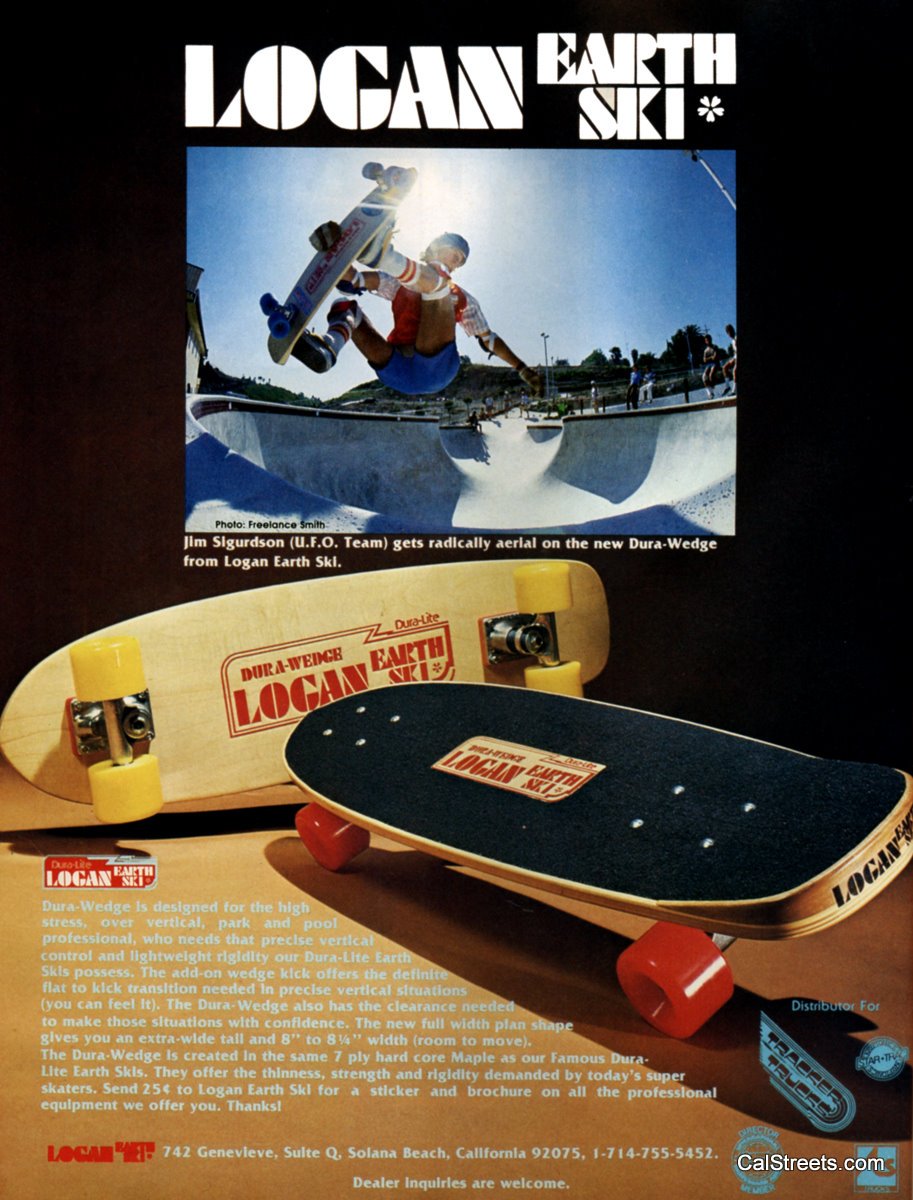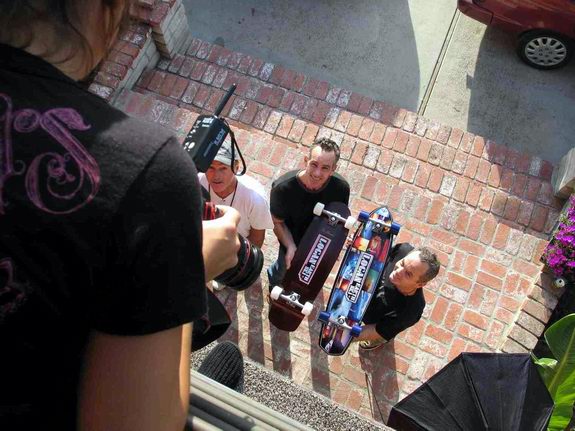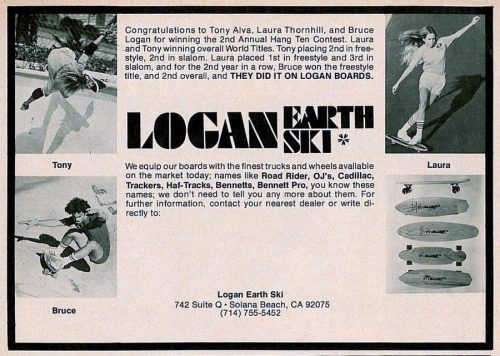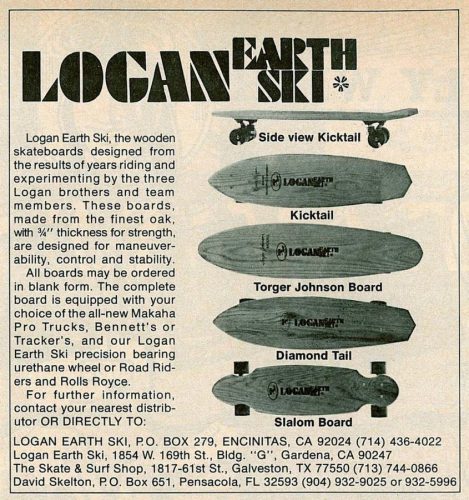

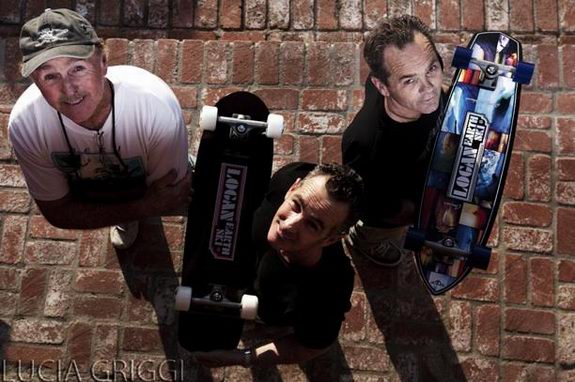
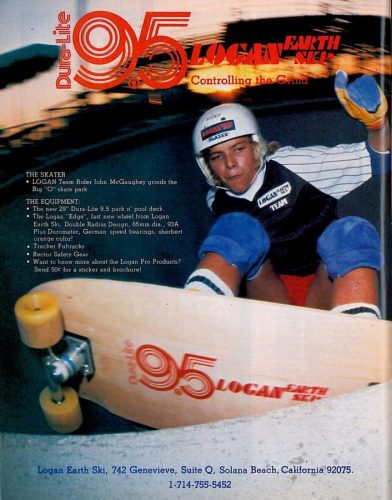
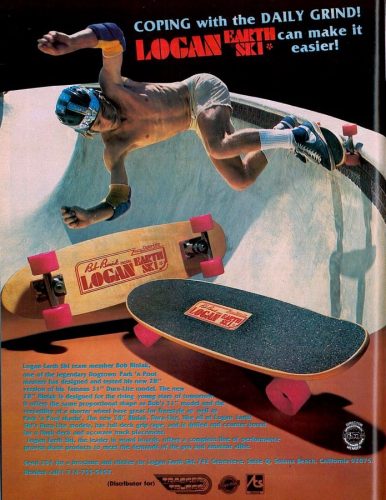
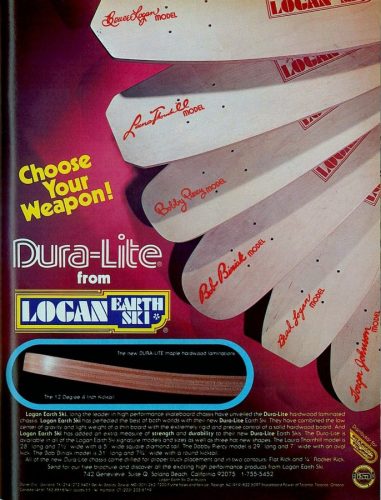
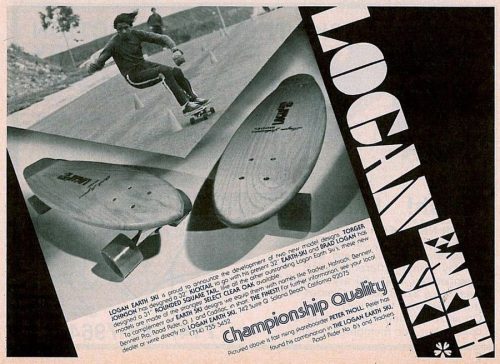
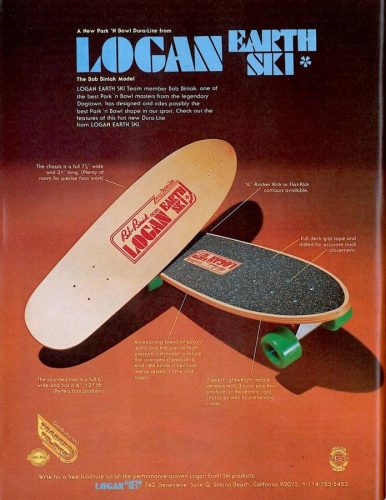
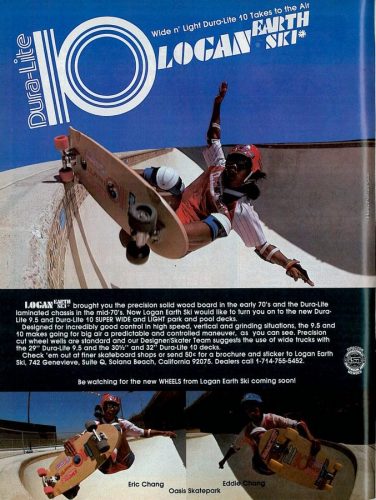
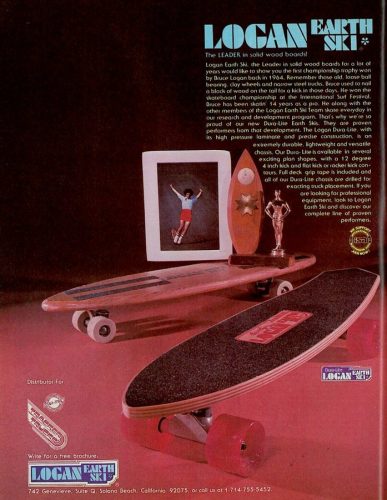 THE BROTHERS LOGAN CLAN LOGAN WE ARE FAMILY Bruce, Brian and Brad on the Origins of Logan Earth Ski. For the full story on the Logan family – whose skateboard roots go back to the 1950s and are still going now – check out their website at www.loganearthski.com. There are five Logans, actually, the three brothers – Brian, Brad and Bruce – plus their sister Robin. But the fifth Logan is their mother, who was behind the scenes and on the sidelines all through the hey days of the Logans – which began in the late 1950s and hit a peak in the 1970s, when Logan Earth Ski was one of the leaders of the urethane revolution of the 1970s – as competitors, as manufacturers as marketers. **Photo Credits Lucia Griggi**
THE BROTHERS LOGAN CLAN LOGAN WE ARE FAMILY Bruce, Brian and Brad on the Origins of Logan Earth Ski. For the full story on the Logan family – whose skateboard roots go back to the 1950s and are still going now – check out their website at www.loganearthski.com. There are five Logans, actually, the three brothers – Brian, Brad and Bruce – plus their sister Robin. But the fifth Logan is their mother, who was behind the scenes and on the sidelines all through the hey days of the Logans – which began in the late 1950s and hit a peak in the 1970s, when Logan Earth Ski was one of the leaders of the urethane revolution of the 1970s – as competitors, as manufacturers as marketers. **Photo Credits Lucia Griggi**
This interview was recorded some time in the fall/winter of 2009, because there is a football game going on in the background.
I remember the Logans from the 1970s and might have even had an Earth Ski, but from doing this book I know Bruce goes as far back as the Anaheim contest in 1965. How far back do you go?
Brian: At least to where we were pulling roller skates apart in the mid-50s. That’s when me and Bruce started doing that: 56, 57, 58.
And where were you guys?
Brad: Hermosa Beach.
Hmm, Hermosa Beach has come up a lot in this book. Hermosa Beach is where Kemp Aaberg saw skateboarders in the late 1950s, and brought it up to Brentwood and Pacific Palisades. Hermosa Beach is where Greg Noll had his surf shop in the late 50s, and claims a guy named Jensen made the first commercial skateboards. Pier Avenue is where the first skateboard contest was.
Brian: Our ancestors in Hermosa Beach go back to the late 1800s.
From Ireland?
Brian: One side of the family is originally from Missouri. Our grandparents are all from there, great grandparents. Hermosa Beach is where Bruce and I started skateboarding in 1959. I would have been nine years old
Where did you get the idea?
Brian: How did we officially start? We probably started out seeing kids on roller skates and then we got the idea: well let’s take these skates apart and nail them to a board.
Bruce: A group of our neighbors and friends from school all started skateboarding. We were taking our skateboards to school and all got together and started a skateboard team. We went to Bing Surfboards on PCH and 101 and asked him if he would sponsor us. And he did.
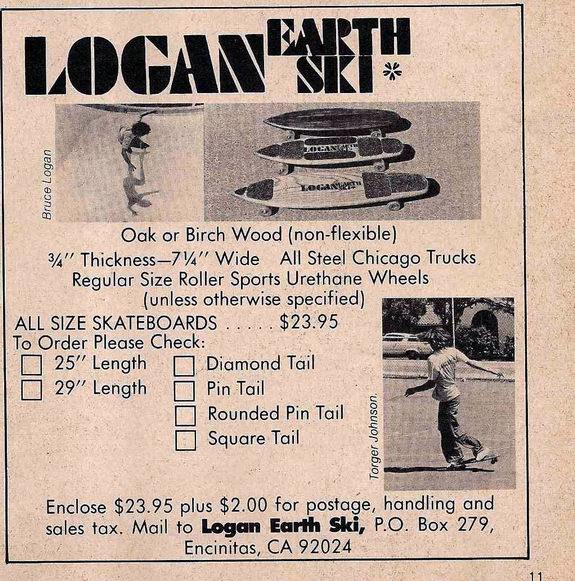 Were you surfing before you were skateboarding?
Were you surfing before you were skateboarding?
Bruce: Our first surfboard that my brothers split was a Velzy Jacobs. Balsawood.
Brian: I can’t remember that.
Bruce: I’ve got a picture of it.
Brian: Bruce has a memory like you wouldn’t believe. More than anybody in skateboarding.
That is what I hear. And what were your skateboards like?
Bruce: Basically a 2” x 4”. We would nail roller skates to a 2” x 4”. We started out at night.
Brian: Swooping turn on the 2” x 4” with steel wheels.
And not slide out.
Brad: That was up on 10th Street in Hermosa Beach.
Brian: And then in the early 60s, we started a skateboard club. I’m only 11 years old, but I was the President, and we’ve got a dozen kids in our little club. We’d go around doing demonstrations and practice at ??? Junior High every day. At first we were the South Bay Skateboard Club and then we got a sponsor – Bing Surfboards – so we switched our name over to the Bing Skateboard Team. And then from there we were some of the first to be on live television. Tony Hawk said it best: “Never underestimate the power of television.”
Brian: I don’t know if you’ve ever heard anyone talk about Surf’s Up with Stan Richards, but that was a big deal.
Bruce: Surf’s Up was 30 minutes of surf footage that they had on once a week, every week, and when they decided to have the skateboard demos on Surf’s Up, skateboarding came up first and then the surf footage. There were about 8 to 10 skateboard teams.
A few people have mentioned it but I can’t find hide nor hair of it online. Nothing on YouTube, unfortunately.
Brian: Check out the archives of KHJ TV Channel 9.
Bruce: Channel 9 on Sundays.
Brian: This was around 1964. There were about 8 to 10 skateboard teams, and it was done live.
What kind of boards?
Brian: Wood boards and Hobie flex
Brad: Fiberglass.
Bruce: Makaha TC Commanders were big.
Brian: Stan Richards show was pretty cool. It was about 8 to 10 teams that were on there and we skated in an alley. Stan was interviewing me because I was head of the team and I would tell him what all the guys were doing. They invited the three top teams back a second time – so we all came back.
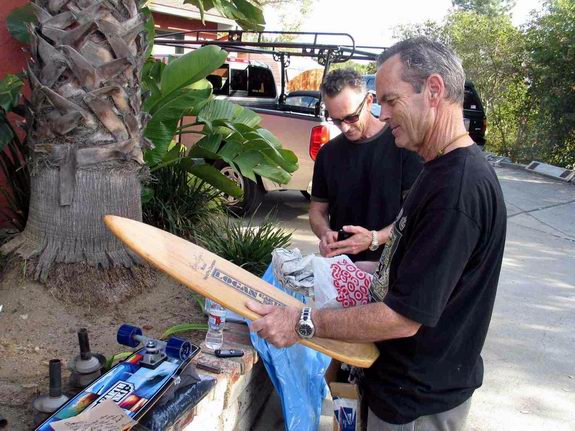 Do you remember who the other two teams were?
Do you remember who the other two teams were?
Brian: Yep. It was Kip’s Skateboard Team, a bicycle shop and I think Bob Moore was on that team and I believe the third team was Hobie, wasn’t it?
Bruce: Not sure, a little hazy on that.
Did all of you compete at Anaheim in 1965?
Brian: Yeah, Bruce got second, behind Torger.
Second in… freestyle?
Bruce: Freestyle.
Brian: I got 11th, I think it was.
We’re hoping to shoot a portrait of the Hiltons next Saturday.
Brian: Tell them we said hi. We haven’t seen them since we were young. We’re all still alive. It’s unusual to get all of us together, because so many have died. Good skaters. We’ve lost a half dozen of our top skaters in the years past.
Brad: Torger Johnson. Baby Paul Cullen. Danny Bearer.
Brian: Most of those people weren’t there from the 60s to the 70s, like us. Torger, Danny Bearer, Bob Moore and one or two more who were there in the 1960s carried over into the 1970s. Not the Hiltons or John Freis or George Trafton.
You guys competed at Anaheim, and then skateboarding died. But you kept skating.
Brian: No competitions.
Bruce: The international surf festival they had from ’64 to ’68. They had Men’s Freestyle, Men’s Slalom and the Men’s Kick turn race.
Brad: They had Junior Boys in those three events also.
Where was this?
Bruce: That was at Pier Avenue Junior High school in Hermosa. The International Surf Festival.
So there were still some things going on.
Brian: Yeah but it just wasn’t the same after that Anaheim contest.
Brad: Between ’65 and ’67 Hobie/Vita-Pakt sent teams out to the schools just to try and keep it going, because I remember they came to our school – Valley Vista School – in ’66…
Bruce: Yeah and Brad won the First Place trophy.
Brian: But very few skateboarders made it from the 1960s to the 1970s.
Brad: Makaha had a team in 1969.
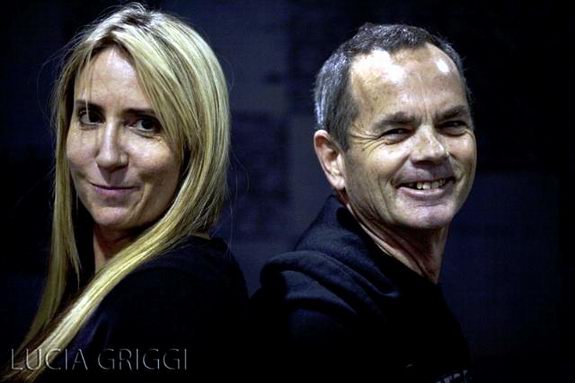
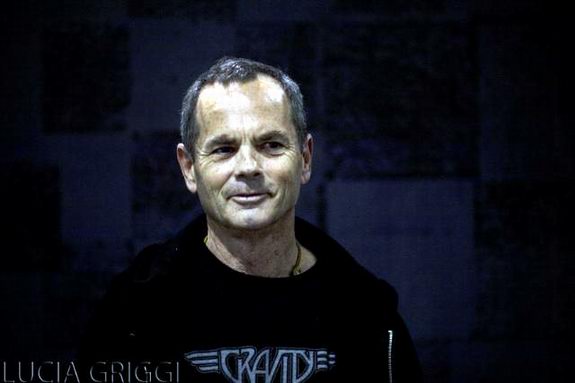
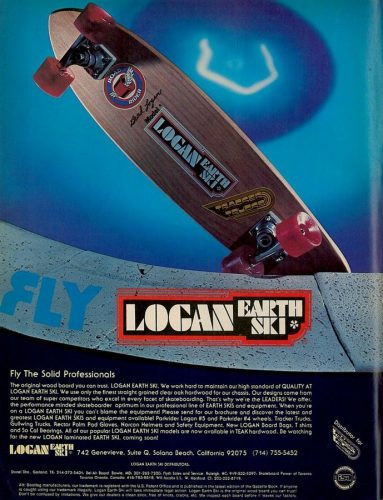
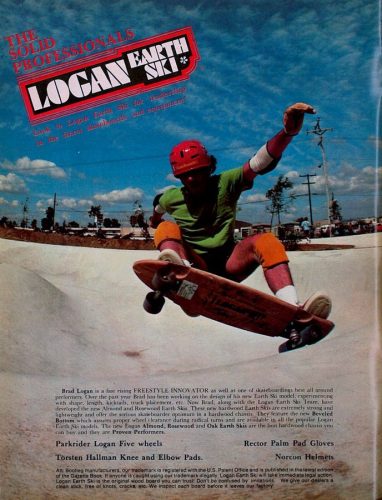 Your company Logan Earth Ski was a 70s company?
Your company Logan Earth Ski was a 70s company?
Brian: In the 70s.
Brad: That was a pre-planned, meditated move on our part
Brian: We started our skateboard company in the back yard. We went out to La Costa knowing this magazine was coming out and I was thinking: ‘Wait until they see Bruce. They’re going to blow their minds.’ Because he had been skating from ’65 on, and he was so far advanced from everybody in the early 70s. We went up to La Costa that first time and people just blew their minds when they saw him. Especially Warren Bolster.
What was going on at La Costa?
Brian: Everything: Downhill, slalom and freestyle.
Why La Costa?
Brian: La Costa was a big mecca for skateboarding back in the 70s because you had this community of beautiful hills with brand-new, paved black streets and sidewalks and no houses.
Bruce: No cars.
Larry Balma said it was built with Teamster money.
Brian: Yep.
Brad: The asphalt was perfect.
Bruce: Black asphalt. Very smooth. You never fell off your board because it was so smooth, and the urethane went over any rock.
Brian: We were some of the first to go out there.
Did you guys start up Logan Earth Ski before urethane, or after?
Brian: Right before, I think. Yeah it was before.
Bruce: It started with Sunset Skateboards.
Brian: It’s close to the same time but it was a little bit before… Bruce was calling them Sunset Skateboards. Remember?
Bruce: That was late ‘69/70 then 71 and 72. It was basically the 29” diamond board like the one over there.
Brad: No kick.
Bruce: No kick, flat deck. That was the same design in the 60s that went into the 70s.
Wood boards….
Bruce: Wood boards.
Brian: Yeah, wood.
Why no kick, was that a patent thing?
Brian: No one was doing kicktails at that time. When the urethane came out we were right there on top of it with the wood boards, because no one was making the wood boards. It was mostly Bahne’s flexible fiberglass boards and a couple of other fiberglass models. That’s all there was, and then we threw ours into the mix, because we knew it worked better.
What kind of wood was it?
Brian: We were using oak for the most part but we started importing wood from South America… rosewood.
Bruce: Some were birch in the early days, too.
Brian: Yeah, some birch.
Brad: Rosewood, almond wood and what was the other wood… teak?
Brian: Teak.
Bruce: They were so heavy that we had to do a bevel bottom on them. Shave off the bottom to make them light.
Brad: Logan Earth Ski and Gordon and Smith were the only companies in the beginning who were paying the royalty to Larry Stevenson for the kicktail.
Brian: But that didn’t last for long.
Bruce: No that didn’t last long at all.
Why didn’t the kicktail royalty last long?
Brian: Because Larry lost in court, eventually. I didn’t like those thick yellow boards with the kicktail. We called them “banana boards.”
Brad: I can’t believe they’re selling for five grand on the Internet. If you can even find them. Just think if Larry had them now.
Were you guys always wood? You never did plastics?
Brian: Nope.
Brad and Bruce: No.
Why?
Brian: Because we thought wood boards worked better.
Bruce: And we were right.
Brad: Because that’s all they use now, anyway.
Bruce: Wood boards are more stable. They didn’t flex.
Is that Laura Thornhill?
Brad and Bruce: Yes.
Brian: She was one of our skaters. She had a model with us. Torger Johnson had a model with us.
Didn’t Alva have a model with you?
Brian: No he was with Z-Flex first, and then he was teamless, and then we took on him and Jay Adams.
Did Z-Flex just fall apart?
Brian: Yeah I don’t know why because skateboarding was really on the upswing at that time. I really don’t know why.
How did Logan Earth Ski survive the downturn at the end of the 1970s?
Brian: Why did skateboarding die in ’79? It died for a combination of a couple of reasons. One is there were a lot of injuries at the skateboard parks and the insurance companies were no longer willing to give the skateboard parks policies. And the other reason is there were too many manufacturers on the market, and you had some really big people involved in skateboards back then. GrenTec, Free Former. They had a lot of money and they put a lot of junk out there on the market.
How did it effect you guys in your business? How abrupt?
Brian: When it ended, it ended just like that for everybody. The phones just stopped ringing, all at the same time. When it ended we had to close our factory in Solana Beach and put all the equipment in the garage and in the next couple of years I didn’t know what to do with it all, so I started burning our old skateboards in the fire place. Little did I know, 35 or 40 years later, these boards that cost me $10 at the time are now worth a few hundred a piece now.
Did you lose a lot of money when the skateboard market collapsed?
Brian: Everything was paid for so theoretically we didn’t, but we lost our livelihood. The one thing we didn’t do – that we regret to this day – is I had the opportunity to sell the business. Back in those days, $1.5 million was a lot of money. I was the only one in my family who wanted to sell the business, and I owned most of it, but they didn’t because they didn’t know what they would do for their livelihood. So we didn’t sell it and a year or two years later… bam, that was it.
So you think you should have sold it?
Brian: Yeah, I know I should have sold it at that time.


